#trc analysis
Explore tagged Tumblr posts
Text
THREES THREES THREES:
Oh hello. I want to talk about the stylistic/textual role of Threes in The Raven Cycle.
Threes – as a general concept and as a number – are a major symbol and motif in the series. Maggie tells us that threes are important from the very first book: from Maura’s favorite saying being “good things come in threes” to Persephone telling Adam that “things are always growing to three or shrinking to three,” threes are discussed at length in the text of the narrative. Maggie also shows us that threes are important as a motif/symbol for important aspects of the story: three Raven Boys, three Fox Way women, three Lynch brothers, three main ley lines, three sleepers, etc. Threes are, textually, incredibly significant in The Raven Cycle, and we know this because we are shown AND told it throughout the entirety of the books.
We all know the significance that is given to threes in the story itself, but what I want to talk about is the usage of a thrice-repeated word or short phrase (going forward I’m referring to this as “Threes” or “a Three”) as one of Maggie’s writing signatures (across the series, there are 65 Threes). This creates a meta level to threes being an important aspect of The Raven Cycle universe. A classic example of a Three (one of my favorites, in fact) is from The Dream Thieves:
“As they walked, a sudden rush of wind hurled low across the grass, bringing with it the scent of moving water and rocks hidden in the shadows, and Blue thrilled again and again with the knowledge that magic was real, magic was real, magic was real.” (TDT, 12)
In a way, the Threes join the intradiegetic (what is happening within the narrative itself) with the extradiegetic (what the narration is communicating solely to the reader). The reader and characters are told explicitly that the number three is significant, important, notable, and powerful. In using Threes as a writing signature after giving the reader that information, the Threes are designed to signal to the reader that this line, this moment, is important.
So the question is: What Are The Threes Trying to Tell the Reader???
Amazing question.
In my recent TRC reread, I was already keeping track of Threes, because I was curious to see how many times they appeared. And then my sister, who was also rereading, said something interesting (after reading this Three from The Raven Boys):
“He was full of so many wants, too many to prioritize, and so they all felt desperate. To not have to work so many hours, to get into a good college, to look right in a tie, to not still be hungry after eating the thin sandwich he’d brought to work, to drive the shiny Audi that Gansey had stopped to look at with him once after school, to go home, to have hit his father himself, to own an apartment with granite countertops and a television bigger than Gansey’s desk, to belong somewhere, to go home, to go home, to go home.” (TRB, 370)
My sister said: “Adam’s like Dorothy.” And then she said: “Wait. Do you think the Threes are like a spell? Or… a wish?”
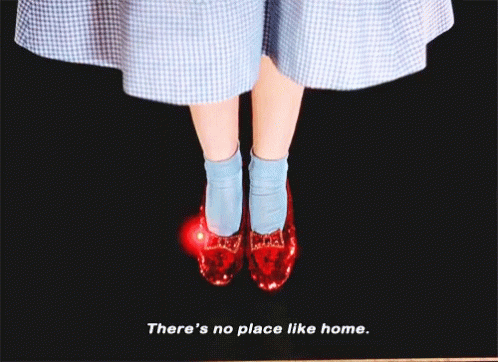
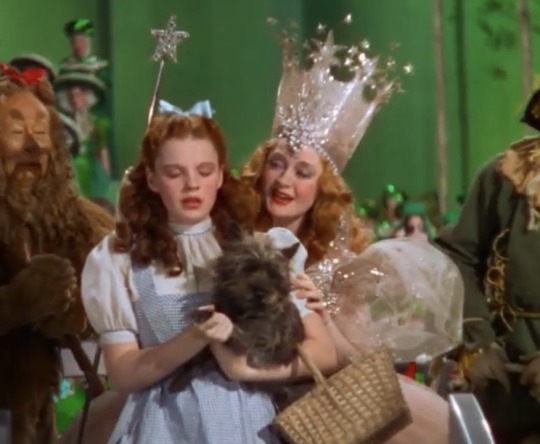
Which was……. Interesting.
What I have determined, after completing my reread and spending way too much time analyzing this, is that a Three is either a wish, a hope, a longing, a prayer – or, alternately, a warning, a curse, a negative promise.
In either sense, Threes are a foreshadowing of what is to come – whether it be good or bad. Threes exist to signal to the reader that they should be paying close attention to whatever is being said or observed.
Threes in….. Everything Else:
Before we get too far into TRC Threes, let’s talk about the precedent for three being an important number in art, math, storytelling, etc. I found some interesting information about how three is a satisfying number for the brain:
Grouping things in threes leverages the power of repetition to aid memory; denote emotional intensity or importance; and ease persuasion (research by Shu & Carlson (2014) found that three positive claims is the most effective for persuasion).
Three is the smallest number that the brain can still recognize as a pattern, and the brain loves pattern and repetition. This is true in visual art – having three main compositional figures to create a pleasing image – and also in storytelling and narrative. Using threes for repetition in storytelling is a very common occurrence.
Some classic examples of repetitive threes are Shakespeare’s “tomorrow and tomorrow and tomorrow” or Lincoln's “a government of the people, by the people, for the people.” In each of these examples, a repetition of three is used to create pleasing auditory rhythm. There is something inherently memorable about literary Threes.
Perhaps the most interesting information I found while digging into the precedent for threes is about the rule of threes in folktales. This information happens to come from Wikipedia (side note: Wikipedia is a modern tool of collective consciousness and we should utilize it more). This page describes how in its most basic form, the rule of threes in storytelling is just beginning, middle, and end. Because this is such a common convention, writers tend to “create triplets or structures in three parts.” It then talks more directly about the use of threes in folktales:
“Vladimir Propp in his Morphology of the Folk Tale, concluded that any of the elements in a folktale could be negated twice so that it would repeat thrice.”
This is especially interesting to me. The idea that an element of a folktale “could be negated twice so that it would repeat thrice” shows up prominently in the plot of The Raven Cycle – a book that is heavily influenced by folktale motifs – but also in so many of the folktales/fairytales we all know. A classic example of this would be Goldilocks and the Three Bears – Goldilocks must try porridge that is too hot, too cold, and then, finally, just right. The journey of these three actions is satisfying to the brain because it is a complete pattern: the third and final result of “just right” porridge is only satisfying because of the two “not right” porridges that preceded it.
Getting back to Stiefvater Threes:
For anyone who’s seen The West Wing (and even those who haven’t), here’s a good way to explain what I think the Threes are doing. You know that thing they do during a The West Wing “walk and talk” where two characters will be throwing information and little quips back and forth at each other rapid-fire, and then suddenly, they will both stop walking, and the camera will stop moving, and they’ll say a line that contains really important information that you need to know to understand the storyline of that episode? That’s what Maggie’s Threes are doing for the reader. That’s what 6:21 is doing for the characters. It’s intentional: the writers/directors/actors/camera operators on The West Wing know that they’re throwing a lot of information at you, and know that they need to get you to pay attention to the most important parts somehow, so they do it by forcing the viewer to lean in and listen. It changes the focus and energy of the scene from something with momentum to something that pauses, and therefore makes you pause.
The Threes compel the reader to pause and consider the information being delivered as more important than they might consider it if it was not written as a Three. “Maura’s expression was dark” does not read the same as “Maura’s expression was dark, dark, dark.” And in a text where characters directly state the magical importance of threes, compounded by three as an overarching motif, there is clear intention and meaning behind these written Threes.
In the context of TRC, Threes act as a fourth-wall break.
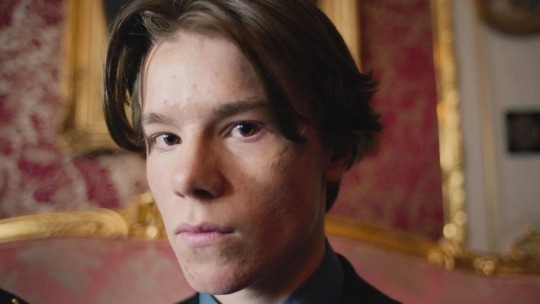
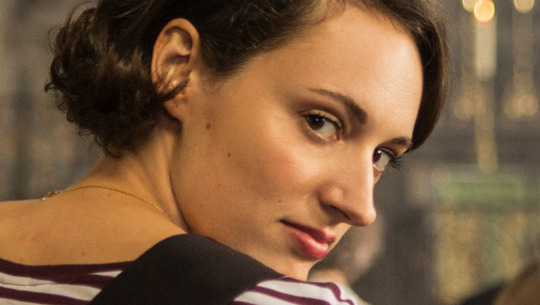
They are essentially a way to poke the reader and say: “Are you paying attention? Because you should be.”
These Threes use a symbolic motif – the rule of three – that is already heavily discussed in the text – to get the reader to pick up on the internal motivations of the character who is “wishing” their Three or the narration which is using a Three to foreshadow some important aspect of the plot.
The Threes are like the literary equivalent of a record scratch. It stops you in your tracks, breaking the established rhythm and making you take notice of what is being said in a new way.
Let’s Look at Some More Threes (but just a few don’t worry)!
1. We get a classic Three, and a very Gansey Three, right after the group comes out of Cabeswater:
“‘What about that thing in the tree?’ Blue asked. ‘Was that a hallucination? A dream?’
Glendower. It was Glendower. Glendower. Glendower” (TRB, 231).
Finding Glendower is one of Gansey’s core wishes, one of his core longings. Although this line is a literal answer to Blue’s question – he saw Glendower in the tree – in making it a Three, Maggie has given it added weight and meaning. It is prayer-like in its intention. It is almost an incantation: by saying it in Three, Gansey wishes it into being.
2. In The Raven Boys, after Gansey has bribed Pinter to keep Ronan at Aglionby and has learned that Noah has been dead the whole time they’ve known him, we are given this Three:
“The Pig exploded off the line. Damn Ronan. Gansey punched his way through the gears, fast, fast, fast” (TRB, 311).
This moment foreshadows what directly follows: a distinct lack of fast as the Camaro breaks down and Gansey is held at gunpoint by Whelk. This Three is not a prayer, but a warning, and an indicator to the reader that something important is about to happen. Had Gansey not been trying to go so “fast fast fast,” the car might not have broken down; because the Three incanted it, disaster follows.
3. To return to a Three I have already mentioned, but follows the typical Three structure:
“...to go home, to go home, to go home” (TRB, 370).
In this scene, Adam’s wish is less about actually wanting to return to his literal home, because his house was never really a home for him. Adam’s wish/longing is for a home that he could return to, that he would want to return to. He is longing for a place/feeling/experience that does not exist for him. The Three in this sentence comes after a string of active wishes/longings, and by ending with this Three, it casts a spell of sorts, honing in on the truest underlying wish that Adam has. In using the phrase “to go home” three times, the narrative is making sure you, the reader, know that this want, this need, this wish, is the most Important to Adam, and will drive his actions for the rest of his story.
Most of the Threes feel like this. They are often tacked on at the end of a sentence or embedded in a sentence. They’re an addendum to the action of the story. They’re like casting a spell – once to manifest, twice to charge, three to cast.
…..And Some Other Types of Threes:
Then there are the Threes that don't follow the typical pattern of the same word repeated three times one right after the other, but are still a Three in a different way.
There are short phrases/sentences that are repeated three times throughout a page or chapter. In the prologue of The Raven King, we get this:
“He was a king…
He was a king…
He was a king.
This was the year he was going to die.” (TRK, 1-3)
In this case, the Three acts as a promise of Gansey’s kinghood, but in ending the sequence with “this was the year he was going to die,” the promise of the three is given a condition: it is not going to be a joyful kinghood, but instead a kinghood intertwined with the death we’ve known is fated for Gansey.
One of Adam’s Threes from Blue Lily, Lily Blue, uniquely breaks the mold of Threes in a format that does not appear anywhere else in the four books:
“It was his father.
He opened the door.
It was his father.
He opened the door.
It was his father” (BLLB, 242).
❋ (We’ll talk about this one more in-depth later.)
There are also a few “unfinished” Threes:
In The Raven King when Ronan is having a nightmare (infected by the demon) about Matthew and the mask, he has this Three:
“Ronan’s throat was raw. I’ll do anything! I’ll do anything! I’ll do anythi
It was unmaking everything Ronan loved.
Please” (TRK, 96).
With the uncompleted Three, there is an uncast wish. Ronan’s wish is about Matthew, yes of course, but also about being willing to do anything to keep those he loves (ie. Adam, Gansey, Blue, his brothers) out of the reach of the “unmaking.” This unfinished Three serves to foreshadow the harm that does ultimately befall first Adam and then Gansey as a result of the unmaking of Cabeswater by the demon: without the Three spell completed, his wish is not fulfilled.
*This is Not all the uncommon/mold-breaking Threes, just a few that are interesting!
Do All Threes Come to Fruition???
The short answer is: No. Or at least not in that way.
Once again looking at the text of The Raven Cycle, we are given an answer of sorts. In discussing Gansey’s predicted death, Maura says:
“First of all, the corpse road is a promise, not a guarantee” (TRB, 155).
This seems to apply to Threes as well. Threes are not a guarantee. They are a promise. Not all Threes come to fruition the way one might expect – or at all, for that matter. The important part of Threes is not that they will definitely come true, it’s that they could come true, because the Three gives them the potential to come true.
Structure, Structure, Structure:
The main Threes structures are:
Three of the same word separated by commas:
“magic, magic, magic” (TRK, 59).
A short phrase/sentence separated by periods:
“My father. My father. My father” (TDT, 369).
A short sentence that is repeated three times throughout a page/paragraph:
“Gansey did not breathe…
Gansey did not breathe…
Gansey did not breathe” (TRK, 209).
A word that is repeated three times and is connected by “and”:
“Round and round and round!” (BLLB, 224)
Italics vs. Non Italics:
Italics in The Raven Cycle are often used for character’s inner thoughts/anxieties. This continues to be true in the context of Threes. A Three that is not written in italics indicates a promise, or some foreshadowing of a plot point being foretold through the Three – it is typically more “real” – whereas a Three that is written in Italics seems to indicate a wish/hope/longing that is unattainable in some way. Italics almost always indicate a Three that may never come to fruition, or at least not in the way the character hopes it will.
An example of this distinction can be found in chapter three (hah) (I don’t believe in coincidences and neither does Gansey) of The Raven King:
First we are met with Ronan wishing/hoping to return home:
“That morning, Ronan Lynch had woken early, without any alarm, thinking home, home, home” (TRK, 24).
This home, home, home, is in reference to the idea of home rather than the reality. Ronan is wishing to return to a home that does exist physically, but is not the same as in his memory – he wants to be at the Barns as it was in his childhood.
Then, in the very same chapter, Ronan actually returns home and we are given this Three:
“Slowly his memories of before — everything this place had been to him when it had held the entire Lynch family — were being overlapped with memories and hopes of after — every minute that the Barns had been his, all of the time he’d spent here alone or with Adam, dreaming and scheming.
Home, home, home” (TRK, 27).
This second home, home, home, is about the actual reality of being in his childhood home – the good and bad that has existed in the years since the childhood he longs for.
The Addition of AND:
The most notable use of “and” is in Noah’s very last chapter:
“Sometimes he got caught in this moment instead. Gansey’s death. Watching Gansey die, again and again and again” (TRK, 416).
When “and” is added into a Three, it becomes circular, cyclical. The “and” gives the Three a sense of infinity, or creates a loop of sorts.
This Three operates in the same way “tomorrow and tomorrow and tomorrow” does in Macbeth – it is meant to convey the endlessness of time, a relentless cycle of tomorrows.
❋ While there are not many of these Threes with “ands” in The Raven Cycle, there are other examples of Threes or Three-like occurrences that fulfill the same purpose as the “and.” For example, remember this Three:
“It was his father.
He opened the door.
It was his father.
He opened the door.
It was his father.” (BLLB, 242).
In this case, instead of the word “and,” the Three (It was his father) is connected by “he opened the door.” This Three is accomplishing the same feeling as “again and again and again” – the feeling of being caught in an endless loop.
Another example of an (implied) “and” in The Raven Cycle is: Gansey’s life. Gansey starts out alive and then dies as a child only to be reborn, and then killed again through his sacrifice, and then reborn for a final time. Gansey is Alive, Dead, Alive, Dead, Alive. And so Gansey’s life is a cycle of Three.
As with the Threes that contain “and,” Gansey starts where he ends: alive.
Other Ways Threes Show up in The Raven Cycle:
I will state the obvious once again: there are three Raven Boys, three Lynch brothers, three Fox Way women, three sleepers, three main ley lines (the lines that “seem to matter” to Glendower’s story), Gansey the Third (Gansey Three, Dick Three).
There are also the more obscure: the “three kinds of secrets” in The Dream Thieves prologue and epilogue; each Lynch brother inheriting three million dollars from Niall Lynch; the three figures with Blue’s face on the tapestry and later as a vision in Cabeswater; Adam and Gansey going to DC for three days; the shield pulled from the lake having three ravens embossed onto it; Ronan having dreamt Matthew at the age of three; the door to the Demon’s room needing “three to open” it; Aurora Lynch staying awake for three days after Niall died.
And of course, we have the ley line symbol/chapter header:
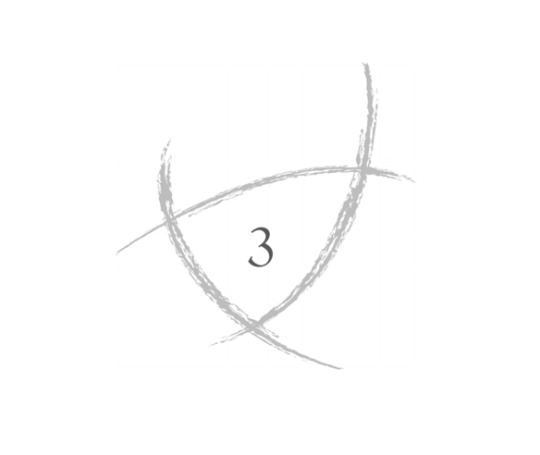
And then there are the 300 (three hundred!) Fox Way “villain” readings. (This was something that was particularly interesting to me.)
The first antagonist we meet is Whelk. When he comes for a reading at 300 Fox Way, he first pulls the Three of Swords.
When the women all draw cards together, they pull identical cards for Whelk: three of the Knight of Pentacles, then three of the Page of Cups. After drawing, essentially, three threes (the Three of Swords, then two sets of three matching cards) in this reading, the first Three of the entire series appears:
“Maura’s expression was dark, dark, dark” (TRB, 124).
The second “antagonist” we meet is the Gray Man, who comes to 300 Fox Way in The Dream Thieves to “observe.” Maura, Calla, and Persephone are predicting which card is on the top and bottom of the stack and the first card, predicted by Calla, is the Three of Cups off the top of the deck that Mr. Gray is holding (a remarkably happy card in stark contrast to Whelk’s Three of Swords).
When the third antagonist, Greenmantle, comes for his 300 Fox Way Reading he also draws the Three of Swords. The fact that each of the three antagonists come for a reading is in itself a sort of Three, but to further the importance of these moments, each of them draws some sort of three-related card.
All of the examples I have touched on have been more symbolic references to Three as a motif of the books as a whole. However, Threes also show up in the literal number of times important quotes are said/written.
I was tracking some of the most well-loved TRC lines to compile them, and noticed that the lines “don’t throw it away” and “safe as life” happen to appear exactly three times throughout the series. This was honestly pretty surprising based on the importance of those quotes – I would have assumed they showed up far more. Actually, they both appear twice in The Raven Boys and once in The Raven King. Threes, and the importance of Threes, is embedded so strongly into the narrative of The Raven Cycle that even the quotes we all think of as the most beloved of the series follow this rule of Threes.
Now, could you chalk some of these up to coincidence? I guess. But Gansey doesn’t believe in coincidences so I don’t either. So what’s the point of all these Threes?
Conclusion???
In a literal, literary way, Threes are a fourth wall break to make the importance of a moment obvious, but I’m not sure what the larger “point” of Threes is. My best analysis comes from the idea of The Raven Cycle being all about time and Threes playing into the importance of time as a sort of record scratch or loop. The Threes, as a stylistic, written motif, seem to connect the time-based cycle the characters experience to the time-based cycles the reader experiences by reading the books.
But my conclusion feels incomplete and so I would like to rely on the collective for this one – just about the most Raven Cycle thing you can do. So I’m asking you, the collective you, what conclusion would you draw? What do you think?
What I do know for sure is that Threes are magic, magic, magic.
For Your Convenience: Here is the textual significance given to threes within the books (chronologically):
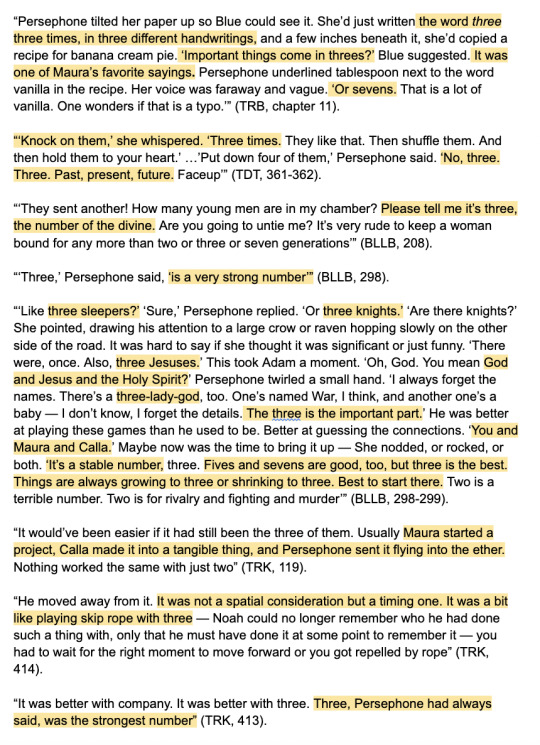
And here are the Threes, Threes, Threes (compiled):


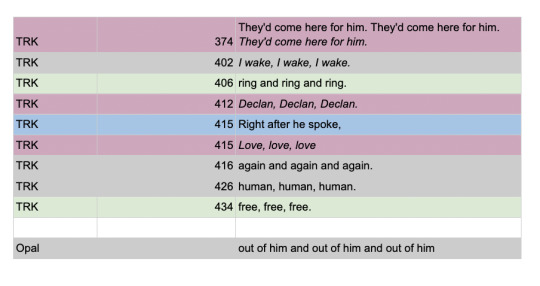
(If you made it to the end of all this, I love you. Have a gold star and a hug <3)
#sorry for the aggressive caps lock i wrote this in google docs#wow this is embarrassing#i'm okay with it#i spent my break writing a 16 page paper#the ganseyism of it all#some people asked for an essay so blame them not me#trc#trc analysis#maggie stiefvater#the raven cycle#the raven boys#the dream thieves#blue lily lily blue#the raven king#the gangsey#blue sargent#richard campbell gansey iii#ronan lynch#adam parrish#noah czerny#gangsey#mine
201 notes
·
View notes
Text
I think it’s really interesting how (as you point out) that we assume Gansey is going to be the one pushing the plot forward. It reminds me of the scene when Gansey realizes in trk that it is the other way around. He has been letting himself be pushed by the plot of the story. I believe he describes himself as a ship being pushed by the sea or something to that effect. His whole arc is realizing, strangely enough, that he does have the agency to change his fate. While Adam is over here forcibly changing his fate (probably as a symptom of being in constant survival mode), Gansey over here spends almost the whole series (completely unbeknownst to us) knowing he is going to die, resigned to the fact he’s going to die, and doing absolutely nothing to change it but delaying the inevitable.
It’s actually incredibly ironic when you think about it. Gansey was over here in the first book telling Adam to leave his house, telling him if he didn't leave he would die, pressuring him to act, to make a choice, to exercise agency when he didn't have any, to save himself. AND YET, Gansey literally had a magical expiration date stamped on his forehead and was just going to let himself die, thinking that he didn't even really matter and that his life wasn't worthy enough to cheat death twice.
God, these characters, man. oof.
Anyway, on another note, I liked the point you made in the post you linked about Adam's arc being set up as an antagonist arc which is SO TRUE. I also picked up on it reading the books for the first time but I didn't quite have the right words for it. After his first pov chapter I just thought, oh this guy is going to be trouble. I'm glad Maggie went in a different direction but still really interesting to think about.
The conversation between Maura and The Grey Man about Gansey and Adam is so meta because they’re basically voicing the audience’s perceptions of the characters.
The narrative is framed so all of us think that Gansey is the Main Character: Richard Gansey and his band of merry men (Maura’s pov)
We all assume this, but as you read the series it becomes increasingly clear that Adam Parrish is the Hidden Protagonist of the narrative. His desire, his need, to control his own life permeates the narrative. Adam takes action even when Gansey is afraid to (stopping Whelk, making the sacrifice) and subsequently propels the plot forward.
This is where The Grey Man’s perspective comes in: Adam Parrish and his band of merry men.
I LOVE that he says this because The Grey Man is an incredibly perceptive character, and while him and Adam have little (if any) interactions, he still notices who is really running the show here. He recognizes that Adam is probably a lot like himself: a guy everyone overlooks but with incredible power to make the difficult decisions everyone is afraid to make. And I just love that The Grey Man, in saying this, shows Adam respect and gives him credit where credit is due.
So this little disagreement between Maura and The Grey Man about who REALLY is the Main Character of this story reflects us. We see Gansey as the protagonist, but we also see Adam Parrish fulfill this role as well. Sometimes, it appears that Adam is even MORE of the main character than Gansey (in my opinion).
And the truth is that they’re BOTH main characters just in completely different ways. It’s honestly insane to me that Maggie can have these two widely different character journeys running parallel to each other in the same series, but she does it. And because they’re so different the development of each entangles and clashes with the other in fascinating and volatile ways.
GOD. It’s just so good I feel like I could teach a class about these goddamn books.
624 notes
·
View notes
Text
no your honor, that character isn’t ‘annoying’ he’s realistically dealing with his trauma and has bpd
#adam parrish#this is about adam#everytime i remember his existence i crj#oh adam im so sorry people dont understand you#im looking at her…#trc#the raven cycle#maybe could be nikolai too idk#bcuz so many people misunderstand him!#there being no actual character analysis on him despite everything abt him 💔#traumtized blonde boys with be the death of me.
66 notes
·
View notes
Text
Declan is described as looking like a combination of Ronan and a polished tailored guy like Gansey or Greenmantle, which in theory makes him like the pinnacle of the type of guys Adam is attracted too. Just don’t tell that to Adam Declan Ronan or Gansey it won’t go over well.
#s speaks#this is important meta analysis not self indulgent at all. it’s not my fault ya’ll don’t read between the lines#adam parrish#decladam#declan lynch#richard gansey#adansey#pynch#ronan lynch#trc#tdt#inspired by that post about how Ianthe is Gideon’s exact type but she’s in denial about it#The Raven cycle#the dreamer trilogy#colin greenmantle
320 notes
·
View notes
Text
i hate how, after seeing all the possible trc hot takes under the sun, and after writing an insane amount of rps set into trc aus, my brain has decided that the ONLY pair of characters it will permanently rotate around like a set of rotisserie chickens is whelk and noah. what do you MEAN i have to keep imagining whelk as being noah's toxic ex, even though i also read them as mostly platonic? what do you MEAN i have to keep fleshing out their backstory myself.
#you know how agnostism is that u dont necessarily NOT believe in god u just dont know if thats something we can know?#thats me. with whelk. and noah. and the ambiguity on the status of what the fuck those two had going on#because the narrative forgot noah so i have to remember him myself#worlds most toxic qpr partner goes to whelk#btw i dont want them to ACTUALLY be together#just want to make that clear#i just see the potential for it. you know? i literally cant remember noah having any other named friends than whelk#whelk really WAS his gansey first. which is insane to think#(also i feel like i stole that analysis from someone but its been years since i saw it. so. apologies for that if ur the one who made that)#trc#the raven cycle#noah czerny#barrington whelk
37 notes
·
View notes
Text
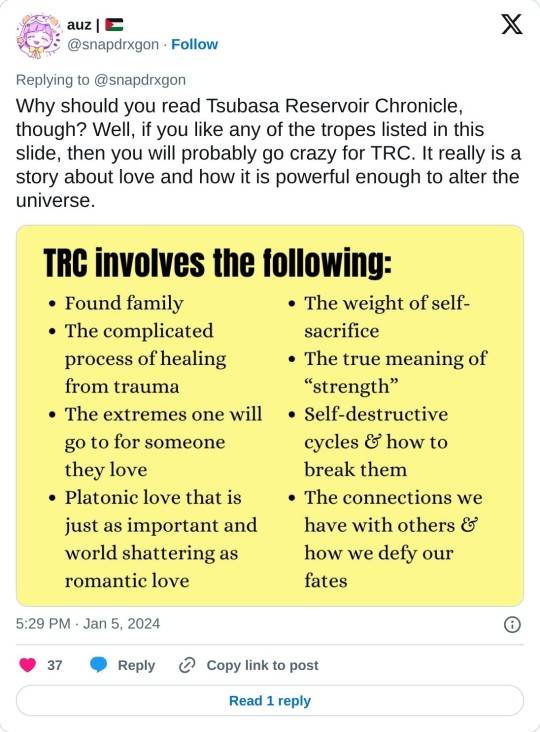

219 notes
·
View notes
Text


the raven boys / the dream thieves
they’d all forgotten that adam was an animal. love this parallel because
1. being his own master w/ the devil/lucifer’s estrangement from heaven + animal autonomy
2. adam (sometimes) believes he is intrinsically bad but this is only (partially) because he was ‘cast out’ by a higher power!
4. many people’s assumptions about adam are wrong. their pitiful “drawings” of him don’t contain his true complexities, and/or at least he thinks they never can.
3. ronan wants to fuck the devil. okay!
4. coca-cola t-shirt 🥺 the archetype of “adam” in red…
#original#trc#the raven cycle#analysis#the raven boys#the dream thieves#adam parrish#ronan lynch#pynch#maggie stiefvater
156 notes
·
View notes
Text
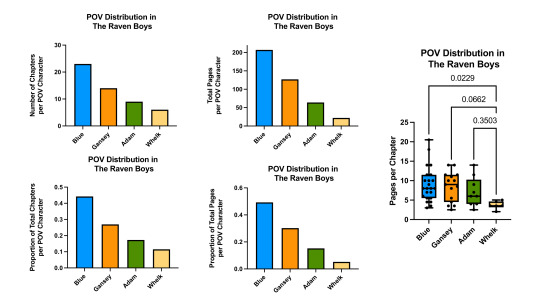
this barbie is quantifying mundane information from a young adult fiction series
#rchl#very fun to run blorbos thru one-way ANOVA w multiple comparisons#if you have an idea for a trc themed spreadsheet or quantitative analysis but don't want to do it. i will lol#trc#trb#the raven cycle#the raven boys#trc data
220 notes
·
View notes
Text
Okay so basically I got to do a presentation about chapter 30 from The Dream Thieves in my Creative Writing class and I got way to carried away writing a full analysis so I thought I'd post it here
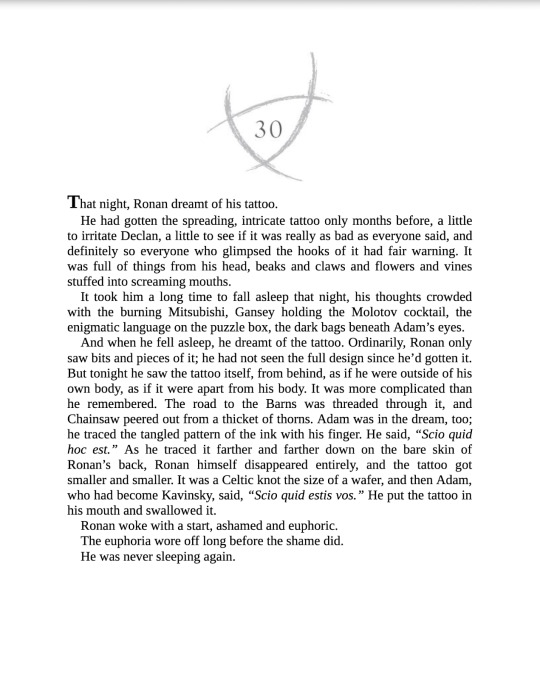
I think this passage is so great because it's packed with symbols that completely encapsulate the character of Ronan Lynch. Firstly, we have Ronan’s tattoo, which holds a lot of significance in terms of its literal purpose and what it figuratively represents. We learn here that the literal purpose of the tattoo is to instill fear and intimidation among others. Ronan is a very damaged person, and uses his physical appearance as a warning sign for others to steer clear of him after his father dies. He has a shaved head, a permanent scowl, and most intimidating of all: a tattoo which stretches from the back of his neck all the way down to his waist. His tattoo has a lot of grotesque, frightening imagery in it, which is interesting considering its design is made up of “things from his head.” The fact that the dark imagery portrayed in his tattoo is from his head reveals the struggles and dark things that come out of his own mind. His tattoo is a literal manifestation of Ronan’s inner self portrayed in a scene on his back. He’s quite literally wearing his heart on his sleeve (or on his back rather). It’s also mentioned that Ronan has never been able to see the tattoo fully, because it’s on his back. It can only be seen by others standing behind him, and also, when he’s naked (which is something I’ll come back to later). I think that the placement of his tattoo specifically is a really important metaphor alongside the idea that Ronan’s tattoo represents his whole character and inner self. The fact that Ronan cannot see the whole picture of himself and only “bits and pieces” seems like a large indicator that Ronan doesn’t know fully who he is. In the prologue of The Dream Thieves, it’s stated that Ronan has three secrets, all of different natures; the nature of the second secret being one you keep even from yourself. So essentially, Ronan has a part of himself which he doesn't even truly understand, and I think that this is really accentuated by the fact that he can't see his whole tattoo (his inner self) because it's always behind him. However, others also can’t see the whole tattoo unless he takes his shirt off to show them. (BIG THING FOR LATER!)
In the epilogue of TDT you find out (along with Ronan himself) that he’s in love with one of his best friends, Adam. During this chapter, the reader hasn’t been told yet that Ronan is in love with Adam; mostly because the book follows his point of view, and he doesn’t actually know this about himself yet either. It’s made into a plot twist of sorts in the epilogue, and many readers said that they weren’t aware that it was coming at all. A lot of people felt that Ronan’s crush on Adam came out of nowhere. But if you’re me and love to look WAY too deep into every single line of a book, you’ll know that this isn’t the case at all. This dream is a dead giveaway of Ronan’s feelings. First of all, dreams–especially the way that they’re portrayed in this book–are a look into one’s inner conscience. Your dreams are able to display your deepest feelings and desires, even if you’re not consciously aware of them in real life. Ronan especially is a character who has walls built up, and doesn't verbally communicate how he feels to any other character. He doesn’t even allow himself to examine his own feelings/desires, and has a lack of self-vulnerability and personal emotional intelligence. So in his dreams, his most inner part of himself comes to the forefront of his mind and shows him things he didn’t even know he wanted. To validate this idea, we have the fact that Ronan can fully see his whole tattoo in this dream. His tattoo represents his inner self, and he is finally able to see this part of himself within his dream. The dream begins with Dream Adam tracing his tattoo, and in Latin (which I’ll unpack later) he says,“Scio quid hoc est” which roughly translates to “I know what this is.” Once again, returning to the idea that Ronan’s tattoo is a manifestation of himself, we have Adam physically touching it and telling Ronan he knows what the tattoo means. He understands its whole purpose; why Ronan got it, what it’s really depicting. Dream Adam isn’t intimidated by the tattoo like most people because of its gruesome imagery, but instead he knows that it’s really made up of things from Ronan’s conscience, that it’s a representation of who he is inside. What’s really being portrayed in this scene is Ronan’s desire to be truly known by someone, which is a common theme in the series. The fact that the person shown “knowing” Ronan in his dream is Adam specifically is really important as well. Up until this point, we know that Adam and Ronan are friends, their relationship is shown to be tense and is characterized by squabbles which are resolved by the end of the day. We don’t really know exactly how they feel about each other yet based on their surface level interactions. Therefore, this chapter is extremely important in developing their relationship. We now know partly about how Ronan truly feels about Adam. Not necessarily what their relationship currently is, but what he subconsciously wants it to be. Ronan wants to be known by Adam and believes that he has this capability, since it’s Adam who fills this role in his dream.
In the dream, Dream Adam then transforms into Kavinsky, who’s the antagonist in this installment. Kavinsky is an adrenaline junky who’s presented to have an infatuation with Ronan. He gets him to do crazy things: dangerously drag race in the streets, take questionable dreamt-pills, and throw molotov cocktails at white Mitsubishis. He’s infatuated with Ronan mainly because of Ronan’s outward reputation and appearance, his mutual love for perilous activities, and the fact that they share the supernatural ability to take things out of their dreams. Kavinsky wants someone to enable him; who he can be an enabler to. Kavinsky thinks that they’re one in the same, and that Ronan is an exemplary candidate for a self-destructive partner. In Ronan’s dream, when Adam turns into Kavinsky, Ronan disappears entirely. He becomes only his tattoo, which gets smaller and smaller until it's simply a tiny Celtic knot. The notion that Ronan disappears and that his tattoo (all that’s left of him, a manifestation of his conscience) gets smaller when Kavinsky appears, shows that he literally feels small when he’s with him. Kavinsky belittles Ronan. He misunderstands who he is, and boils him down to his wildness and rash spontaneousness. He quite literally swallows Ronan whole in the dream; he destroys all that he is. Dream Kavinsky tells Ronan in Latin, “Scio quid estis vos'', which roughly translates to “I know what you are.” WOOOOOF. OH, IT'S SO GOOD. I GOT CHILLS. This could have SO many meanings. “I know what you are” could mean that Kavinsky knows that Ronan is a dreamer, just like himself, or it could also mean that he knows Ronan is gay (if we’re revisiting that idea of this dream bringing to the forefront parts of Ronan that he doesn’t know about himself yet). Adam and Kavinsky are complete opposites in Ronan’s dream, and furthermore, his life. The dream versions of the two represent what he wants, versus what he’s settled with. Currently, Ronan doesn’t think that he’s worthy of someone who truly knows and loves him. Instead, he’s resigned himself to a homoerotic unlabeled relationship with Kavinsky—who doesn't actually care about who he is, and only wants someone who he can destroy his life with. The exact phrasing of the things Dream Adam and Kavinsky separately say to Ronan are SO significant. Essentially they’re telling him the same thing: what they think they know about him. It's the words which they use to say this which makes these statements wildly different. Dream Adam says “I know what this is” about Ronan’s tattoo, meaning that he knows Ronan’s inner self. He knows this thing which he can’t normally see all of himself display of terrible things from his own mind. Dream Kavinsky says “I know what you are” which displays his assumption of Ronan’s outer character. It’s a bold assumption and an incorrect one. The difference between Adam and Kavinsky to Ronan, is that Ronan wants Adam because he’s different from himself, and doesn’t want Kavinsky because he’s too similar to him. To an extent, I think Ronan fears Kavinsky because he’s who Ronan would be if he didn’t have Gansey or Adam in his life to keep him sane. Initially, Ronan does like to have someone to let off steam with, but he eventually realizes doesn't want an enabler to ruin his life with. He wants someone like Adam–his polar opposite–to know him, to ground him. He wants to feel alive, and awake.
Another interesting element to this chapter is that Ronan’s dream seems to be erotic in nature; it’s a wet-dream. This is a little jarring for a YA novel, but I personally think eroticsm and sex used in literature as metaphors for conveying relationships and character vulnerability is really beautiful and clever. The significance of it being a sex dream is the fact that Ronan, as previously stated, isn’t someone who verbalizes his love for people. He shows it through physical intimacy and acts of service. Intercourse is literally as close as one can be with another person, and Ronan is completely vulnerable and laid bare in this moment. In it Ronan is naked, which we know because the dream begins with Adam tracing the tattoo all the way down his bare back. Remember, Ronan’s tattoo can only be seen fully when he’s naked, which adds another layer to this. Here it’s assumed that he had allowed Dream Adam to see his tattoo, because he had to have taken off his shirt to see it. Circling back Ronan’s tattoo placement, it’s something that not only can’t be fully seen by himself, but also can’t be fully seen by others unless he decides to strip naked for them. Here he allows Adam to see it and even trace the lines of it down his back. He felt comfortable enough to be vulnerable with Adam like that, and to inspect his whole being. The fact that Kavinsky then appears and the tattoo becomes smaller represents Ronan's uncomfortability with Kavinsky. He didn’t mean for him to see that part of himself and shrinks away in shame until Kavinsky devours the tattoo without permission. It really enforces the idea that Ronan wants and chooses Adam, but Kavinsky forces himself into his life and takes from Ronan without asking. Finally, Ronan awakes from his wet dream “euphoric and ashamed.” This could either be about the fact that it was a sex dream with not one, but other boys, or the confrontation of his true desires. He’s ashamed to admit what he really wants, and doesn’t allow himself to fully comprehend what this dream means. Ronan even thinks that he never wants to sleep again, which really means that he doesn't want his dreams to confront him with his true feelings again. This can tie into the metaphor about Ronan’s sexuality in terms of the fact that he got off to Adam and then Kavinsky, or that he doesn’t want to let his guard down and admit what he truly wants.
It’s now finally time to unpack the use of Latin! Hooray! Throughout the series, we’re shown that Ronan is really flippant about school. He’s constantly on the brink of expulsion from Aglionby because he doesn’t go to any of his classes or do any of the work. However, the one class he has consistent attendance in as well as the highest overall grade is Latin—second to his proficiency in the language is Adam. They’re both in the same class, and are said to be able to almost fully understand and speak perfect Latin. The use of this dead language is a common theme in the series, and almost all of Ronan’s dreams are in latin. There’s an underlying meaning in that alone. A fun tidbit if we’re looking into the meaning of latin phrases we have the imagery of “claws and beak” described about the imagery of Ronan’s tattoo. The latin phrase “Unguibus et rostro” translates to “claws and beak” and is an expression about fighting with everything you have for something you want. It’s idiomatically comparable to phrases like “heart and soul” and “with all one’s strength” (thanks to ravenclawsandbeak on tumblr for sharing this finding with the fans). In the final book in the series, there’s a short chapter which is essentially a call-back to this chapter, and follows the format in which it’s written pretty clearly. However, Ronan is awake this time rather than dreaming.

This chapter is more or less a sex scene between Ronan and Adam, and is essentially the exact opposite to Ronan’s wet dream in TDT. Here, Ronan’s desires are no longer a fantasy that came to him in a dream, he finally has exactly what he’s wanted all along. in which they admit their feelings for each other, which is done indirectly and not through words. The fact that it's through a sex scene is significant because it's showing their intimacy. Intercourse between people is literally as close as two people can get. As a couple, Adam and Ronan rarely verbalize their feelings about each other, and so this intimate act is really them letting down their walls and allowing themselves to be completely vulnerable to each other. Here, we have Adam studying Ronan's tattoo in real life this time, just like in his dream (Something he’s only able to do because Ronan allowed him). He sees all the fine details in its design, and interestingly enough, speaks aloud this latin phrase “Unguibus et rostro” (This also begins a common theme of Ronan and Adam speaking in cryptic latin phrases rather than just actually telling the other of how they feel about each other, but that's a story for another time). This, as everything else does, has multiple meanings; it shows that not only Adam correctly interprets the imagery on tattoo, showing that now he does truly know and understand Ronan’s inner self. But also it reiterates the meaning of this phrase: that Ronan has appropriately fought with all he had for what he wants. He was able to reject Kavinsky and stay true to himself and his principles, and he realized his feelings for Adam, and was able to let his guard down enough to reach out to Adam and let him know how he actually felt about him. And similarly, he allowed Adam to love him back.
So why did Maggie Stiefvater include the chapter in TDT? It completely breaks the flow of the main story, interrupts two other character’s POVs, and comes seemingly out of nowhere. It's not described where Ronan is, who he came to sleep, when it’s happening. It feels as if the placement of this chapter didn’t matter; it could appear anywhere and still have the same effect. My theory? I think that Stiefvater specifically placed this chapter here because she thought it was an appropriate time to learn more about Ronan, and she wanted the chapter to stick out due to shock value. Because it’s at such a seemingly random moment, and its content is brief and strange, it’s a stark outlier from the rest of the chapters. For me, this strategy totally worked. When I think back to this book, this chapter is by far the most memorable one. I remember it almost immediately when I think about any specific line/chapter from this book. Even though the dream seems random and complex, it has so much meaning packed into it about Ronan’s inner conscience and character. Stiefvater wants to reveal all of these things about Ronan previously analyzed without directly telling us.
#trc#the raven cycle#the dream thieves#the raven king#ronan lynch#adam parrish#joseph kavinsky#ronan's dreams are weird and i love them#literary analysis#lit analysis is my passion and so is this book
51 notes
·
View notes
Text
i’m so normal about ronan lynch (he consumes my every waking thought)
#not in a crush way tho#more in a character analysis way#like i want to know everything about him#his story is gutwrenching#ronan lynch#pynch#adam parrish#the raven cycle#trc
123 notes
·
View notes
Text

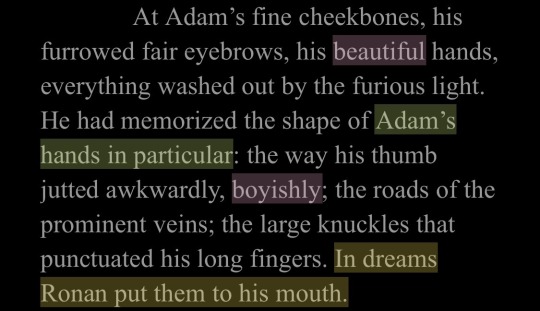
do you get it. do you even understand
cloud cuckoo land, anthony doerr // the raven king, maggie steifvater
#web weaving#the raven cycle#trc#ronan lynch#adam parrish#pynch#cloud cuckoo land#book analysis#the raven king#trk#ccl x trc#trc x ccl#mine
74 notes
·
View notes
Text
there’s this really interesting parallel between the raven king in trc and the raven king in aftg. not the books, but the figures and perceptions of glendower and riko themselves.
in trc, glendower is this great-man-cum-genie’s-wish. he is man and myth in one. gansey’s focus on the yet-to-be-confirmed magic of glendower instead of the very real magic that exists all around him makes it so that, when glendower is found to be impotent, gansey sees no other solution to stopping the story’s great evil than his own sacrifice. we know there was another solution all along, stemming from a magic there had been tangible proof of since book one, but gansey still dies, even if he is ultimately revived.
in aftg, riko is made a god through his parasocial relationship with his fans. there’s a mythology around him: his perfect court and the fact that he was trained from childhood by one of the inventors of the game he plays, at the most prestigious program in the world. but behind the scenes, riko is propped up by a criminal organization and encouraged by his mentor to abuse his power. this, combined with neglect, turns him into the root of worst things to happen to each of our three main characters: kevin’s hand breaking, drake finding andrew, and neil’s dad finding him.
both riko and glendower end up exposing the main characters to almost dooms, glendower passively through the power of gansey’s faith, and riko actively through the power of the public’s adoration.
#anyway the moral of the story is never idolize anyone#trc#birdverse#aftg#riko moriyama#glendower#owain glendwr#owain glendŵr#gansey#richard gansey iii#kevin day#andrew minyard#neil josten#i op#analysis#meta
59 notes
·
View notes
Text
RONAN LYNCH AND ADAM PARRISH ARE MOTION SICKNESS BY PHOEBE BRIDGERS
#fuck im doing lyrical analysis as soon as I finish this writing piece im working on#phoebe bridgers#adam parrish#ronan lynch#trc#the raven cycle#pynch
9 notes
·
View notes
Text
the trc books are such BOOKS
#just spent 3 hours annotating one of my copies of them#(i bought a second set specifically for analysis based annotation)#(i also have annotation in my original set of the books but that's in pencil and mainly just thoughts as i read)#anyway yeah i was writing a bunch in mainly dream thieves around the adam with ronan's dad's mask dream scene#and then in raven king and raven boys and#then i reread that murdered - remembered noah scene and cried about him because he's such a sad sad character#i love them all incredibly much wow#i don't even really have a point to this they're just very on the brain again#trc#sasha talks
12 notes
·
View notes
Text
“Gansey tossed off his overcoat — beneath it, he was in a T-shirt and pajama pants, which was possibly the most metaphorical outfit Adam could imagine for his friend, unless he could manage to wear another overcoat beneath the T-shirt, and another set of pajamas beneath that second overcoat, so on and so on, an endless matryoshka of Ganseys — and cast himself onto the end of the bed.”
Insane description Adam’s like he’s so complex what a marvel I definitely will be having some dreams about removing his clothing layer by layer tonight
#and about making out wearing masks of each others faces who said that—#s speaks#s rereads bllb#trc reread notes#trc#adam parrish#richard gansey#adansey#more of the hard hitting analysis you are here for.#my meta
24 notes
·
View notes
Text
trc did do nice job at tying in the dog motif to make the gansey family status a bit dehumanizing
“…he had been told he was destined for greatness. He was bred for it; nobility and purpose coded in both sides of his pedigree.” (raven king prologue)
compared to the barking always mentioned at the trailer park & dog-walking being one of blue's multiple jobs. ronans violence gets lotsa dog imagery, even in-universe.
#i guess trc stands out from other YA because analysis isnt just expected its rewarding. ykwim?#probablyrambles#trc#dog motif#gansey#the raven cycle#the raven king
10 notes
·
View notes